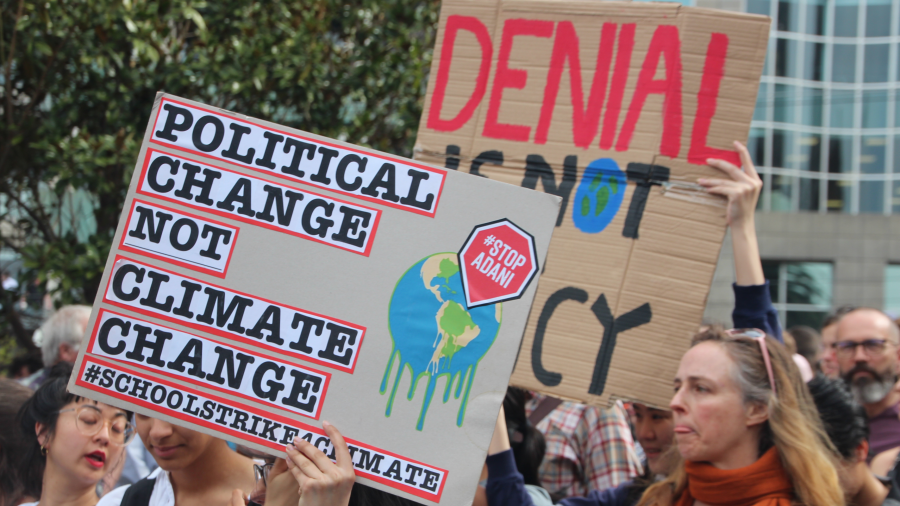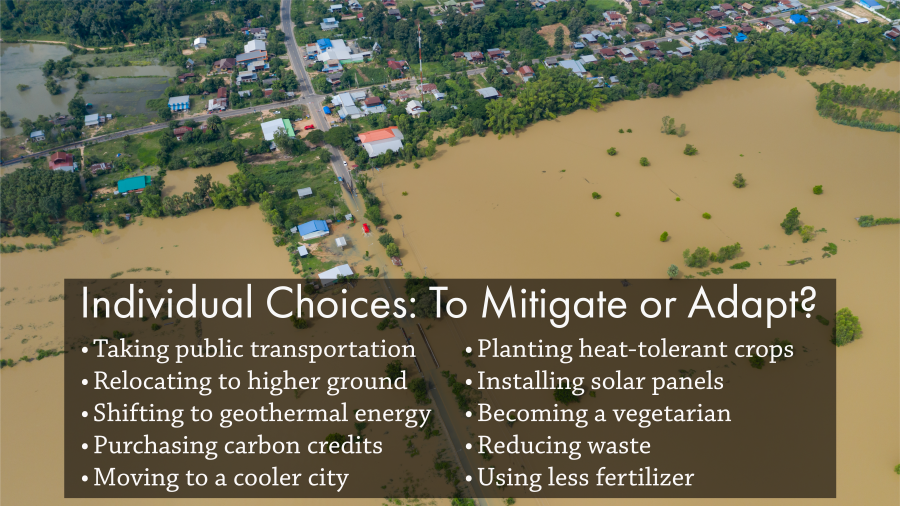
A downloadable version of this lesson is available here:
No longer viewed as a potential or as something happening far into the future, global climate change is here. The earth’s climate is on a path to reach temperatures that modern humans have never experienced. Along with higher temperatures, droughts, wildfires, and flooding are exceeding what our infrastructures can withstand. In the scientific community, the consensus that these changes are due to human activities stands at 99.9% (Lynas et al. 2021). The United Nations’ Intergovernmental Panel on Climate Change (IPCC) has shown that emissions of heat-trapping gasses have almost warmed the earth by 2°C since pre-industrial times. Humans have many choices for how to confront the challenges this warming has created. Perhaps, the best option is to change individual behaviors in ways that will reduce greenhouse gas (GHG) emissions (Steg et al. 2023). While unlikely to halt climate change by itself, lowering GHG emissions can slow climate change effects, and with sufficient changes, it may mean future generations experience fewer impacts. Other choices include implementing government policies that restrict emissions, replacing petroleum-based energies with renewable sources, and using improved carbon-capture technologies that reverse or slow some of the effects of climate change (Fawzy et al. 2020).
This lesson briefly reviews introductory concepts around climate change, including how emissions cause warming, which gases are involved and how they are produced, and what international policy is doing with respect to the Paris Agreement. The primary assignment involves individuals or groups selecting a climate change-related problem, conducting research on the problem, and then developing a presentation on the causes behind the problem, as well as potential mitigation and adaptation strategies. The lesson assumes the instructor will reserve at least 30 minutes in a follow-up session for the project presentations and a class discussion; however, the instructor could also opt to have learners submit the completed projects for assessment.
- Understand what GHGs are, where they come from, and what the relative contributions of natural and anthropogenic sources are to climate change.
- Describe the Paris Agreement and recognize countries coming closest to meeting their commitments.
- Distinguish between, define, and provide examples of climate change mitigation and adaptation in the context of a specific socio-environmental problem.
- Research and cite scholarly sources.

This figure provides a list of choices that individuals could make. Classify each one as a choice to mitigate climate change or to adapt to it.
The time required to complete the steps in this lesson is 50 minutes, which allows the instructor to introduce the topic, challenge the learners with questions using the provided slides, and allow them to begin their projects. If the instructor can set aside some additional time (~30 min.) in a later session, learners can present their results and engage in a little bit of discussion. Alternatively, instructors may choose to have learners turn in the projects so that the instructor can provide constructive comments or, if it is a class, a grade.
-
Reading: Prior to the session, have learners do the following:
Read the short 2021 document by Adam Behsudi that explains the difference between adaptation and mitigation and that provides a few examples. The article is readily available from multiple sources online, including from the International Monetary Fund eLibrary.
Read the sections for at least 10 strategies listed under Climate Change Mitigation Strategies, developed by Earth@Home.
-
(5 min.) The Hook. Have learners complete the Hook, jotting down their lists of individual mitigation vs. adaptation choices, also shown on Slide 1 of the lesson’s PowerPoint. The learners will return to their responses toward the end of the lesson when asked to distinguish mitigation from adaptation.
Document -
(20 min.) Slides and Questions for Discussion. Move through the remainder of the PowerPoint slides, pausing on each slide that poses a question to the learners. Give them time to respond even if they are just guessing. The slides with questions are as indicated in the below bullets. Notes to the instructor are provided with each slide; many suggest follow-up points or explain potential responses.
Slide 2: What is the physical process behind the warming effect of GHGs?
Slide 4: Most global warming emissions come from which GHGs?
Slide 5: What are the sources and sinks of these dominant GHGs?
Slide 8: Why does warming keep accelerating?
Slide 10: Which countries are emitting the most GHGs—total and per capita?
Slide 13: What are the choices? How does mitigation differ from adaptation?
-
(5 min.) Group Assignment. Divide the assembly into groups of two to three and then introduce the project assignment outlined in the bullets below and covered briefly on slide 16; instructors can opt to have learners do projects individually. Learners will have time to select a topic and begin work during the session. A list of potential project topics is provided on Slide 17; however, participants may identify a topic on their own and seek approval to use it. Each learner or group should complete the tasks in each of the below bullets and prepare a presentation.
Describe the causes (ultimate/proximate), environmental impacts, and social or economic impacts associated with the topic. Note that some topics may be multi-dimensional in cause or consequence, so learners should feel free to focus on one or more of the dimensions.
Propose two mitigation strategies that can be deployed to reduce or eliminate impacts. For many of these topics, there will be strategies that have applications at different scales, but learners should try to focus on implementation strategies at regional or country scales. Provide a list of at least two citable sources (scientific or scholarly papers) that informed what the learners found. If they determine that citable evidence is only available for strategies at larger scales, they may discuss those.
Propose two adaptation strategies that would foster coping with or being resilient to the impacts associated with your topic. The same directions as in the last bullet apply (i.e., focus on regional or country scales and include citable references).
-
Individual or Group Work. With whatever time is remaining, learners should identify their topics and begin their work. Let them know if they will be giving a presentation in the next session or will be submitting their presentation and accompanying materials to the instructor. If they are working in groups, remind them to make sure they have one another’s emails or other contact information since they will need to meet outside of the session to complete the tasks and presentation.
-
Quantifying the potential for climate change mitigation of consumption options
This article is helpful in providing examples to go with the lesson assignments. It reviews various literature on different options for reducing consumption, including our choices of food, housing, and transportation. It identifies the options with the highest climate change-mitigation potential, as well as ways to change behaviors that appear fixed.
Ivanova, D., Barrett, J., Wiedenhofer, D. et al. (2020). Quantifying the potential for climate change mitigation of consumption options. Environmental Research Letters, 15, 093001. https://iopscience.iop.org/article/10.1088/1748-9326/ab8589/pdf
-
Strategies for mitigation of climate change
This article, also referenced in the lesson’s overview, briefly reviews conventional mitigation technologies (e.g., renewable energy, carbon capture and use); negative mitigation technologies (e.g., bioenergy C capture & storage, reforestation, soil C storage); and radiative forcing geoengineering (e.g., stratospheric aerosol injections, cirrus cloud thinning). This information is useful if learners have difficulty finding ideas for their group assignment.
Fawzy, S., Osman, AI.., Doran, J. et al. (2020). Strategies for mitigation of climate change. Environmental Chemistry Letters, 18, 2069. https://doi.org/10.1007/s10311-020-01059-w